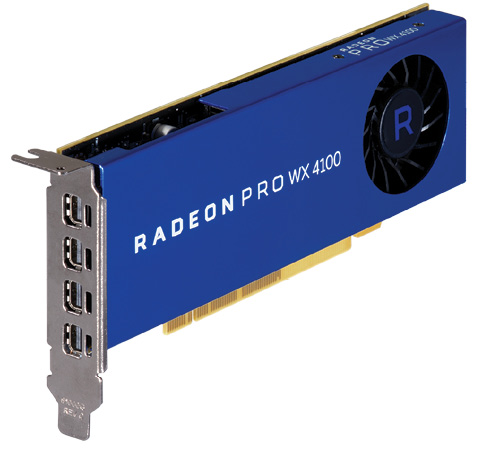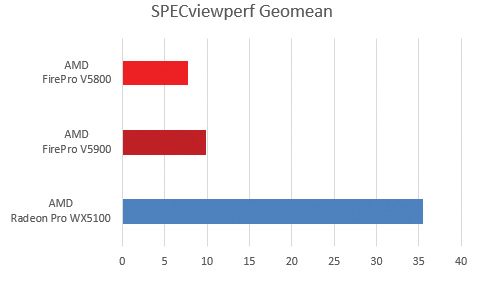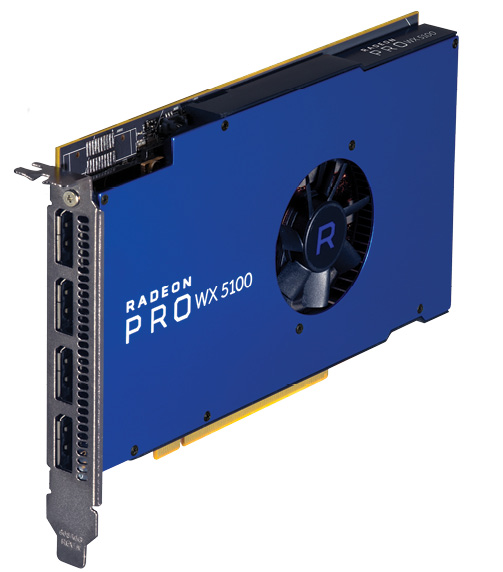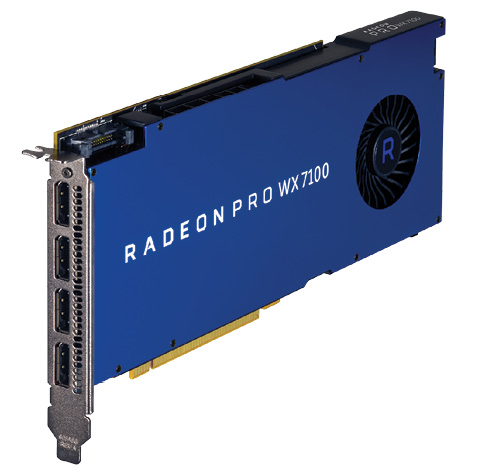AMD Radeon Pro Review: A New Name and a New Look

Fig. 1: The AMD Radeon Pro WX 4100 low-profile workstation graphics card.
Latest News
April 5, 2017
In early November 2016, AMD began shipping the latest generation of its professional workstation-class graphics cards, first announced at last year’s SIGGRAPH conference (see “AMD Launches New Graphics Cards).” It has been a few years since we last had an opportunity to do a hands-on review of the company’s graphics boards, so we were quite pleased when a new AMD Radeon Pro WX 5100 arrived at our test lab.
Although AMD has long been known as a competitor to Intel in the CPU market, the Sunnyvale, CA company moved into graphics in a big way in 2006 when it acquired Canadian graphics card manufacturer ATI and took over development of the ATI FirePro graphics boards. AMD continued to use the FirePro name on its professional workstation-class cards until now. With the release of AMD’s new Radeon Pro WX series, the name and the ATI red, white and black color scheme appear to be history.
A Closer Look at the Three New Boards
The new Radeon Pro WX series consists of three new boards, based on AMD’s Polaris architecture: the Radeon Pro WX 4100, Radeon Pro WX 5100 and Radeon WX 7100. All three are based on the company’s fourth-generation Graphics Core Next (GCN) technology, but are now manufactured using a 14nm FinFET process that reduces active power consumption and provides more transistors to allow for more compute units and cache. According to AMD, the Polaris architecture also leverages these additional transistors for new intelligent features such as “aggressive primitive culling,” which helps to improve performance and energy efficiency, and quality-of-service to reduce contention between graphics and compute shaders. The Polaris architecture is implemented using custom and adaptive circuit designs that dynamically run the silicon at the highest frequency and lowest voltage possible, further boosting the energy efficiency of Polaris-based graphics processing units (GPUs). AMD claims that the combination of all these innovations is “a next-generation graphics architecture that is up to 2.8 times more power efficient while helping improve visual quality with high-dynamic range display and media encoding and decoding quality for the latest content.”
The Radeon Pro WX 4100 graphics card is billed as the world’s fastest low-profile workstation graphics GPU, with a claimed performance of 2 TFLOPS for single-precision. With a manufacturer’s suggested retail price (MSRP) of $399, it essentially replaces the FirePro W4100. The new board comes with 4GB of GDDR5 memory (double the memory of its predecessor) and 16 compute units for a total of 1024 stream processors (vs. 512 in the older board). Like the W4100, the new Radeon Pro WX 4100 has a 128-bit interface, a maximum power consumption of 50 watts, and provides four mini DisplayPorts. Although display resolution for the W4100 maxed out at 4K, the new WX 4100 can power a single 5K display or up to four 4K monitors.
 The performance of the new AMD Radeon Pro WX 5100 compared with previous generation AMD FirePro boards.
The performance of the new AMD Radeon Pro WX 5100 compared with previous generation AMD FirePro boards.The mid-range AMD Radeon Pro WX 5100 replaces last year’s FirePro W5100. AMD claims that the WX 5100 is the fastest 75-watt workstation GPU. Although it matches the older board’s $499 manufacturer’s suggested retail price (and has an average street price of $399), it provides 8GB of GDDR5 memory (double that of the W5100) and 28 compute units for a total of 1792 Stream Processors (compared with 12 compute units and 768 stream processors in the older board). That actually equals the number of processors in AMD’s previous high-end FirePro W7100. The WX 5100 also has a 256-bit interface, twice that of its predecessor. AMD claims a peak performance of 3.9 TFLOPS for single-precision. Like its predecessor, the WX 5100 consumes a single slot and provides four DisplayPort connectors. The WX 5100 also supports CrossFire Pro that enables users to harness the power of two GPUs by linking two identical Radeon Pro cards together. The board also supports stereo 3D via an expansion bracket. Unlike its predecessor, however, the new Radeon Pro WX 5100 can support up to two 5K displays.
At the high-end, AMD introduced the Radeon Pro WX 7100, which the company touts as the world’s fasted single slot workstation GPU ready for VR. With an MSRP of $799, the WX 7100 supplants the FirePro W7100. Although it matches the 8GB of GDDR5 memory of the W7100, it is equipped with 36 compute units for a total of 2304 Stream Processors. Although the WX 7100 consumes just a single PCIe x16 slot, its 150-watt power consumption requires a six-pin auxiliary power connection. Like its predecessor, the WX 7100 provides four DisplayPorts, but again ups the ante by supporting up to two 5K displays. Like the W7100, the Radeon Pro WX 7100 supports stereo 3D via an additional bracket, supports framelock/genlock via an additional module, and also supports CrossFire Pro.
Testing the Radeon Pro WX 5100
Because we only received the new Radeon Pro WX 5100, that was the only board we were able to test. We typically compare new graphics cards with the previous generation by testing the new boards and the older boards in the same workstation and using the same video driver so that the only variable is the GPU itself. In this case, however, because we never had the opportunity to test the previous generation of AMD graphics boards, we had to go back a few years.
We therefore compared the new AMD Radeon Pro WX 5100 with the older AMD FirePro V5900 and FirePro V5800 graphics boards. We ran version 12 of the SPECviewperf benchmark (spec.org) using a BOXX workstation (boxx.com) equipped with an Intel Core i7-4790 quad-core CPU (over-clocked to 4.5GHz) and 16GB of memory, running Windows 10 Pro. We also used this same workstation to test the latest graphics cards from NVIDIA (see “Super Computer Graphics,” page 36), so you can make direct comparisons.
The performance improvement over the older boards we were able to test was quite dramatic. Although we would not expect the difference compared with the more recent boards to be as significant, we tend to believe AMD’s claimed performance improvements.
All three new AMD Radeon Pro graphics boards support high dynamic-range (HDR) displays, higher contrast ratios and a wider color gamut than the previous generation. They also support higher resolutions (up to 5120x2880, or 5K) and higher refresh rates (up to 96Hz at 3840x2160, or 4K via DisplayPort 1.4 and 3840x2160 at 60Hz via HDMI 2.0b).
Like previous AMD boards, all new Radeon Pro WX series graphics cards are fully certified with most engineering design applications. The new boards utilize a new Radeon Pro Software Enterprise Driver, which is different from the unified video drivers used by older FirePro cards. But as was true previously, the new driver is available for Windows 7, Windows 10 and Linux—but only for 64-bit versions of those operating systems.
The three new boards come with 24/7 VIP customer support, a three-year limited warranty and now feature an optional free seven-year extended limited warranty upon product and customer registration. Clearly, AMD is ready once again to go head-to-head with NVIDIA.
| AMD Radeon Pro WX7100 NEW! | AMD FirePro W7100 | AMD Radeon Pro WX5100 NEW! | AMD FirePro W5100 | AMD Radeon Pro WX4100 NEW! | AMD FirePro W4100 | |
| Estimated street price (at launch) | $799 | $799 | $499 | $499 | $399 | $399 |
| Average street price (today) | $630 | $399 | $260 | |||
| SPECIFICATIONS | ||||||
| Extra power required | Yes | Yes | No | No | No | No |
| Form factor (inches) | 4.38x9.5 | 4.38x9.5 | 4.38x6.8 | 4.38x7.31 | 4.38x6.8 | 4.38x6.5 |
| Slots used | 1 | 1 | 1 | 1 | 1 | 1 |
| Max Power (watts) | 150W | 150W | 75W | 75W | 50W | 50W |
| PCLe version | 3.0 | 3.0 | 3.0 | 3.0 | 3.0 | 3.0 |
| Processors | 2304 | 1792 | 1792 | 768 | 1024 | 512 |
| Memory configuration | 8GB (GDDR5) | 8GB (GDDR5) | 8GB (GDDR5) | 4GB (GDDR5) | 4GB (GDDR5) | 2GB (GDDR5) |
| Memory interface | 256-bit | 256-bit | 256-bit | 128-bit | 128-bit | 128-bit |
| Memory bandwidth | 244 GB/s | 160 GB/s | 160 GB/s | 96 GB/s | 96 GB/s | 72 GB/s |
| Number of DVI Dual Link Outputs | 0 | 0 | 0 | 0 | 0 | 0 |
| Number of Display Port Outputs | 4 DP | 4 DP | 4 DP | 4 DP | 4 miniDP | 4 miniDP |
| Stereo 3D Connector (3-pin) | Yes (1) | Yes (1) | Yes (1) | Yes (1) | No | No |
| Framelock/Genlock | Yes | Yes (1) | No | No | No | No |
| Multi-GPU (SLI-NVIDIA) | Yes | Yes | Yes | Yes | No | No |
| OpenGL version | 4.5 | 4.4 | 4.5 | 4.4 | 4.5 | 4.4 |
| DirectX/Shader Model | 12/5.0 | 12/5.0 | 12/5.0 | 12/5.0 | 12/5.0 | 12/5.0 |
| Maximum Resolution Support | 5120x2880 | 4096x2160 (2) 2560x1600 (3) | 5120x2880 | 4096x2160 (2) 2560x1600 (3) | 5120x2880 | 4096x2160 (2) 2560x1600 (3) |
Specifications for the new AMD Radeon Pro-series graphics boards compared with the previous generation AMD FirePro W-series. 1. With optional expansion bracket; 2. Resolution with DisplayPort 1.2; 3. Resolution with DisplayPort 1.1
More Info
Subscribe to our FREE magazine, FREE email newsletters or both!
Latest News
About the Author
David Cohn is a consultant and technical writer based in Bellingham, WA, and has been benchmarking PCs since 1984. He is a Contributing Editor to Digital Engineering, the former senior content manager at 4D Technologies, and the author of more than a dozen books. Email at [email protected] or visit his website at www.dscohn.com.
Follow DERelated Topics









